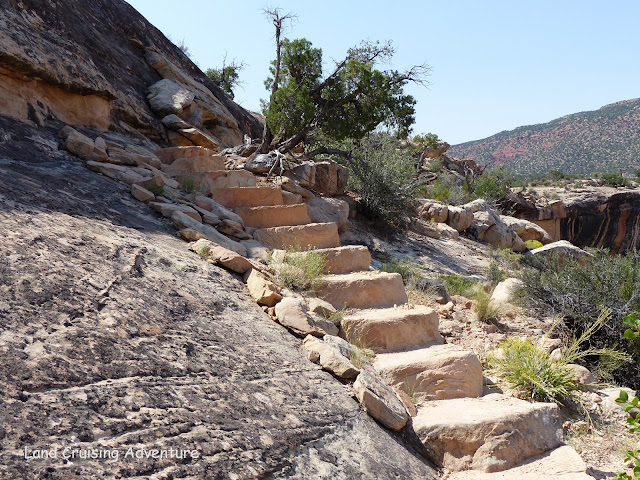This monument includes three natural "bridges" of stone, which are different from arches in this area. The bridges are made from erosion through the years by water moving through the rock. Arches are made by other types of erosion.
In order to actually see these bridges up close, you have to hike down to them. Otherwise, you're standing there on the overlook and seeing a rock area with trees and other plants. On occasion, the bridge just blends into the other rock areas. Still, it's a beautiful area, with lots of canyons and rocks worn through the years. You can see the arch below, behind the trees in the middle of the photo.
I elected to hike down to the second bridge, it was labeled as "strenuous", but they've timed it at 1 hour round trip. Going down into the canyon is the easy part, gravity really helps. Most of the trail consisted of steps either carved into the rock walls or made and cemented in place.
In a few places they had guardrails to hold onto because the rock was very steep, even when steps were carved into them. In one place, there was a small ladder.
When I finally arrived at the canyon floor and walked over to the arch, it was massive and very impressive. It was red rock, arching over 200' over my head and spanned 200 feet from side to side. The canyon floor at that point was full of rocks and water still flows through the arch, as evidenced by some standing water off to the side.
The next arch was totally different and as you can see by the photo below, it pretty much blends into the scenery.

I wasn't planning on hiking down to this one, since the hike up from the canyon floor was hot and I'm still having trouble with the high elevation and lack of oxygen. However, it wasn't that far and it was labeled only "moderate", not strenuous. So, I decided to go for it. It was impressive when I got down the trail, but I liked the red rock one better. This one is only about 100' high, and the span was only 180'.
Most of the rest of the scenery looks typically like the photo below - canyons shaped by water, wind and time.


















































